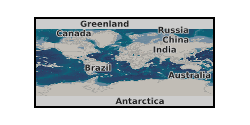Experimental friction dataset for heterogeneous and homogeneous mixed quartz-clay fault gouge layers (NERC Grant NE/P002943/1)
The data are from a suite of friction experiments performed on simulated fault gouges comprised of clay-quartz mixtures, sheared in a direct-shear arrangement. Some experiments were performed on gouge layers comprised of adjacent patches of kaolinite-clay and quartz (i.e. heterogeneous gouge layers), whereas others were performed on homogeneous mixtures of the two materials (i.e. homogeneous gouge layers). More information on the different types of experiment is provided in the accompanying metadata for this dataset. The relative proportions of clay and quartz were varied in different experiments. All experiments were performed at an effective normal stress of 40 MPa. The sliding velocity was stepped between 0.3 and 3 microns/s every 1 mm of displacement to calculated the rate-and-state friction parameter (a-b). The evolution of shear stress was monitored with increasing displacement (up to a maximum displacement of 8.5 mm).

non geographic dataset
:
http://data.bgs.ac.uk/id/dataHolding/13607747
English
Geoscientific information
GEMET - INSPIRE themes, version 1.0:
BGS Thesaurus of Geosciences:
Fault gouge
NGDC Deposited Data
Friction (geomechanics)
Heterogeneity
Free:
Free:
NERC_DDC
creation: 2021-04-22
2018-02-12
-
2020-08-12
University of Liverpool
John Bedford
School of Environmental Sciences, 4 Brownlow Street,
Liverpool,
L69 3GP
email:
not available
Role: originator
University of Liverpool
Professor Daniel Faulkner
School of Environmental Sciences, 4 Brownlow Street,
Liverpool,
L69 3GP
email:
not available
Role: principal investigator
British Geological Survey
Enquiries
email:
not available
Role: distributor
British Geological Survey
Enquiries
email:
not available
Role: point of contact
Data Quality
Data were collected by shearing gouge layers in a direct-shear arrangement within a high-pressure triaxial deformation apparatus. Normal stress is applied by the confining pressure and pore fluid pressure is introduced to the gouge layer through sintered steel porous disks on each direct-shear forcing block. The forcing blocks are displaced, and thus the gouge layer is sheared, by the axial piston of the triaxial apparatus. An internal force gauge within the axial piston measures the axial force, which is used to calculate the shear stress acting on the gouge layer.
INSPIRE Implementing rules laying down technical arrangements for the interoperability and harmonisation of Geology
Commission Regulation (EU) No 1089/2010 of 23 November 2010 implementing Directive 2007/2/EC of the European Parliament and of the Council as regards interoperability of spatial data sets and services
Constraints
The copyright of materials derived from the British Geological Survey's work is vested in the Natural Environment Research Council [NERC]. No part of this work may be reproduced or transmitted in any form or by any means, or stored in a retrieval system of any nature, without the prior permission of the copyright holder, via the BGS Intellectual Property Rights Manager. Use by customers of information provided by the BGS, is at the customer's own risk. In view of the disparate sources of information at BGS's disposal, including such material donated to BGS, that BGS accepts in good faith as being accurate, the Natural Environment Research Council (NERC) gives no warranty, expressed or implied, as to the quality or accuracy of the information supplied, or to the information's suitability for any use. NERC/BGS accepts no liability whatever in respect of loss, damage, injury or other occurence however caused.
Available under the Open Government Licence subject to the following acknowledgement accompanying the reproduced NERC materials "Contains NERC materials ©NERC [year]"
licenceOGL
Metadata about metadata
c12dbbc2-5ea2-67f2-e054-002128a47908
British Geological Survey
Environmental Science Centre,Keyworth,
NOTTINGHAM,
NG12 5GG,
United Kingdom
tel: +44 115 936 3100
email:
enquiries@bgs.ac.uk
Role: point of contact
2024-04-24
